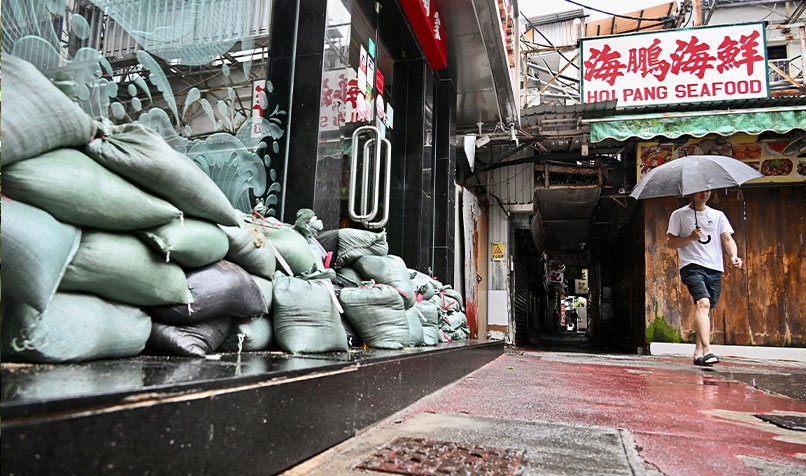Loading component...
At a glance
- While significant tipping points are unlikely in the next 10 years, temperatures are expected to be higher for longer.
- 90 per cent of climate risks and exposures are within the supply chain and outside of business operations.
- Organisations that have invested in climate mitigation ahead of the curve are reaping financial benefits today.
When the world meteorological organization confirmed 2024 to be the hottest year on record, United Nations (UN) Secretary-General António Guterres responded by describing global warming as a “cold hard fact”. As Gueterres put it, blazing temperatures in 2024 require “trail-blazing climate action in 2025”.
The effects of climate change at the aggregate level are widely discussed — from rising sea levels to the increasing severity of extreme weather events. As governments around the world consider various forms of climate action, their citizens want to know what will happen where they live.
If the impact of climate change accelerates over the next decade, how will it impact business, and where we live and work? Here’s what the climate experts say about the potential impact in four specific locations: Hong Kong, Singapore, Sydney and Melbourne.
Hong Kong

A densely populated city-state surrounded by sea water, Hong Kong experienced its warmest year on record in 2024.
The Hong Kong Observatory recorded an annual mean temperature of 24.8 degrees, which was 1.3 degrees above the 1991–2020 climatological normal.
Heavy rain is far from unusual in Hong Kong, especially during the summer months. However, recent weather patterns have caused concern, with two consecutive typhoons — Typhoon Saola and Typhoon Haikui — sweeping across the region within less than two weeks in September 2023. Record-breaking rainfall brought much of the city to a halt, with flash flooding submerging metro stations and causing widescale business disruption.
"Typhoons are not new for Hong Kong, but the intensity is getting stronger, and they are becoming more frequent and more difficult to predict. In 2024, we had three typhoons close to Hong Kong, two to three days apart."
A 2018 sea-level study also warned that Hong Kong’s sea level is set to rise anywhere between 0.63-1.07 metres by the end of the current century.
Felix Leung, head of social and climate action at The Chinese University of Hong Kong’s Jockey Club Museum of Climate Change, says weather patterns are changing.
“Typhoons are not new for Hong Kong, but the intensity is getting stronger, and they are becoming more frequent and more difficult to predict. In 2024, we had three typhoons close to Hong Kong, two to three days apart.
“People who live in low-lying areas near the northwest of Hong Kong will experience flooding more frequently.”
Leung notes that rising temperatures in Hong Kong are accompanied by a higher concentration of ozone, which is associated with health issues such as respiratory disease.
A record-breaking drought in 2022 in China caused some rivers, including parts of the Yangtze, to dry up, halting shipping and forcing major companies to suspend operations, Leung adds.
“That is just one example of how climate change can impact businesses,” he says.
Singapore
A low-lying island state of 734.3km2, Singapore’s urban density, limited land area and low wind speeds present challenges in pursuing alternative energy options.
Singapore’s Third National Climate Change Study, published by the Centre for Climate Research Singapore, notes that the city-state’s annual mean temperature has increased by 0.24°C per decade in the past 40 years.

Winston Chow, professor of urban climate at Singapore Management University and co-chair of the United Nations’ Intergovernmental Panel on Climate Change’s (IPCC) Working Group II, says there has been a shifting baseline of warmer temperatures that are reflected not just in the averages, but also in the extremes.
“If nothing is done in terms of capping greenhouse gas emissions over the next 10 years, we'll see more hot spells and we'll see more periods where the heat index that combines heat and humidity will be more intense.”
Chow notes that, on average, rainfall in Singapore is not projected to change substantially. “We still get almost 2.4 metres of rain a year, but the challenge is that there appears to be increasing periods of more intense and short-duration rainfalls that occur,” he says.
“And, once it hits the ground, if it can't go into drains or enter the soil, it ponds and floods, leading to traffic disruptions and inconveniences in public transportation.”
Along with the impact on physical infrastructure, Chow says climate change may also affect social infrastructure.
"At the IPCC, [in Singapore] we’ve seen cases of people choosing to move to a safer place for themselves and for their families, and usually these are the people that have high amounts of knowledge capital and financial capital."
“At the IPCC, we’ve seen cases of people choosing to move to a safer place for themselves and for their families, and usually these are the people that have high amounts of knowledge capital and financial capital.
“If you are a city manager in a coastal city, this means your tax revenue may drop when people start leaving and, for c-suite folks, your best and brightest personnel may want to relocate.”
A key climate impact for Singapore is food security, Chow says.
“We import more than 90 per cent of our food from elsewhere,” he says. “The short-term fluctuations in terms of price can have massive downstream cascading impacts on markets that Singapore depends on for importing agricultural and food products into the island.”
Towards net zero: Asia’s green transition
Sydney and Melbourne
Flooding in New South Wales (NSW) costs the state’s economy about A$250 million every year and the NSW Government notes that climate change is expected to make storm and flood events more severe. Research from the University of New South Wales also shows that rapid rain bursts in Sydney have been 40 per cent more intense in the past two decades.
Sea-level rise is expected to cause most sandy beaches on the NSW coast to recede, but this physical impact may not be experienced for many decades and is dependent on the level of future greenhouse gas emissions. Approximately 80 per cent of the NSW population live within 50 kilometres of the coast.
Melbourne is also experiencing more intense storms and flooding, as well as sea level rise. In 2018, for example, the city experienced a one-in-1000-year rainfall event, with 50mm of rain falling in 15 minutes.
The City of Melbourne predicts that climate change will cost the local economy A$12.6 billion by 2050 and will impact agriculture, tourism, insurance and finance.

“There’s natural variability in our climate in Australia, and then there’s climate change in the background. We will see the effects of climate change through changes in our natural climate fluctuations,” explains Dr Jaci Brown, research director for the Climate Intelligence Program and the lead of CSIRO’s Climate Science Centre.
“Australia is used to dealing with tough climates, and that’s a strength, but we can expect extra pressure on top of that due to climate change.
“There's unlikely to be any big tipping points in the next 10 years — rather a continuation of the changes we are already recording. We’re already experiencing hotter conditions and, when you look to 2035, we can expect it to be hotter for longer.”
Brown says hotter temperatures are a greater concern for cities like Sydney.
“What does that look like for your workers if you’re in the healthcare sector, for example? If you’re in the health industry, are you ready for the impact on public health during a summer of more heatwaves, especially if you are working with vulnerable populations?
"You may have bushfires in a region and you start to rebuild, but then the heavy rain comes soon after, or another bushfire — so it’s about being equipped to deal with this high variability and increasing frequency of extreme climate and weather."
“The impact of bushfires may be a bigger issue for Melbourne, due to the smoke blowing in from affected areas in Victoria and impacting air quality,” adds Brown.
However, it is not just about preparing for singular events, Brown notes. “You may have bushfires in a region and you start to rebuild, but then the heavy rain comes soon after, or another bushfire — so it’s about being equipped to deal with this high variability and increasing frequency of extreme climate and weather.
“[Australia’s] resilience to deal with all of those things happening at once is going to test us.”
Prepare for climate risks
Adrian King, partner, ESG advisory and assurance at KPMG Australia, says a first step in preparing for the impact of climate change is understanding a business’s exposure.
“Whenever we do a Scope 3 analysis, which covers emissions up and down the supply chain, 90 per cent of all climate risks are in that category,” says King.
He notes that once the business understands the risks, the team can take steps to manage them. “Do you diversify your supply chain? Do you change it? Do you find alternative suppliers? Do you lock in low-cost and low-carbon supplies?”
The next step, says King, is to examine the business’s exposure.
“You can then do what most organisations are very good at, which is using common techniques, such as the 80-20 rule, to make sure that you understand the lion's share of your emissions, where they're coming from or what the exposures are, and then focus on those areas.”
Alan Dayeh, partner, sustainability strategy and financial services at sustainability and climate change consultancy ERM, says quantifying risks can present challenges to organisations.
“There are toolkits that risk management professionals have for looking at past loss events, and these are quite useful, but every organisation will have their own vulnerabilities and exposures that they’ll need to work through.”
Dayeh adds that organisations that have invested in climate mitigation ahead of the curve are reaping financial benefits today.
“I’d encourage CFOs and accountants to think more strategically about working with chief sustainability officers or those who are driving climate change risk and opportunity management internally,” he says. “Then, rather than looking at cost line items that need to be struck out, start asking questions.
“‘What’s the strategic advantage of us making that capital investment or incurring that operating expense? What do we have to gain by maintaining this kind of cost of delivery?’ Then, connect the dots and understand that part of the role of the team that’s managing climate change within your organisation is also contributing to its strategic growth.”
What is IFRS S2 all about?
IFRS S2 requires an entity to disclose information about climate-related risks and opportunities in their annual financial statements. These include physical risks as well as transition risks associated with moving to a lower-carbon economy.
Information to be disclosed includes:
- governance processes, controls and procedures related to climate-related risks and opportunities
- strategies for managing climate-related risks and opportunities
- processes used to identify, assess, prioritise and monitor climate-related risks and opportunities, including whether and how they are integrated into and inform the overall risk management process
- performance in relation to its climate-related risks and opportunities.
Checklist for SMEs
The International Federation of Accountants (IFAC) has produced the Small Business Sustainability Checklist, a diagnostic tool to help SMEs identify sustainability areas, risks and opportunities.
IFAC recommends SMEs work with their accountants for guidance and recommendations on sustainability matters, including establishing systems to capture the required information and relevant best practices.

